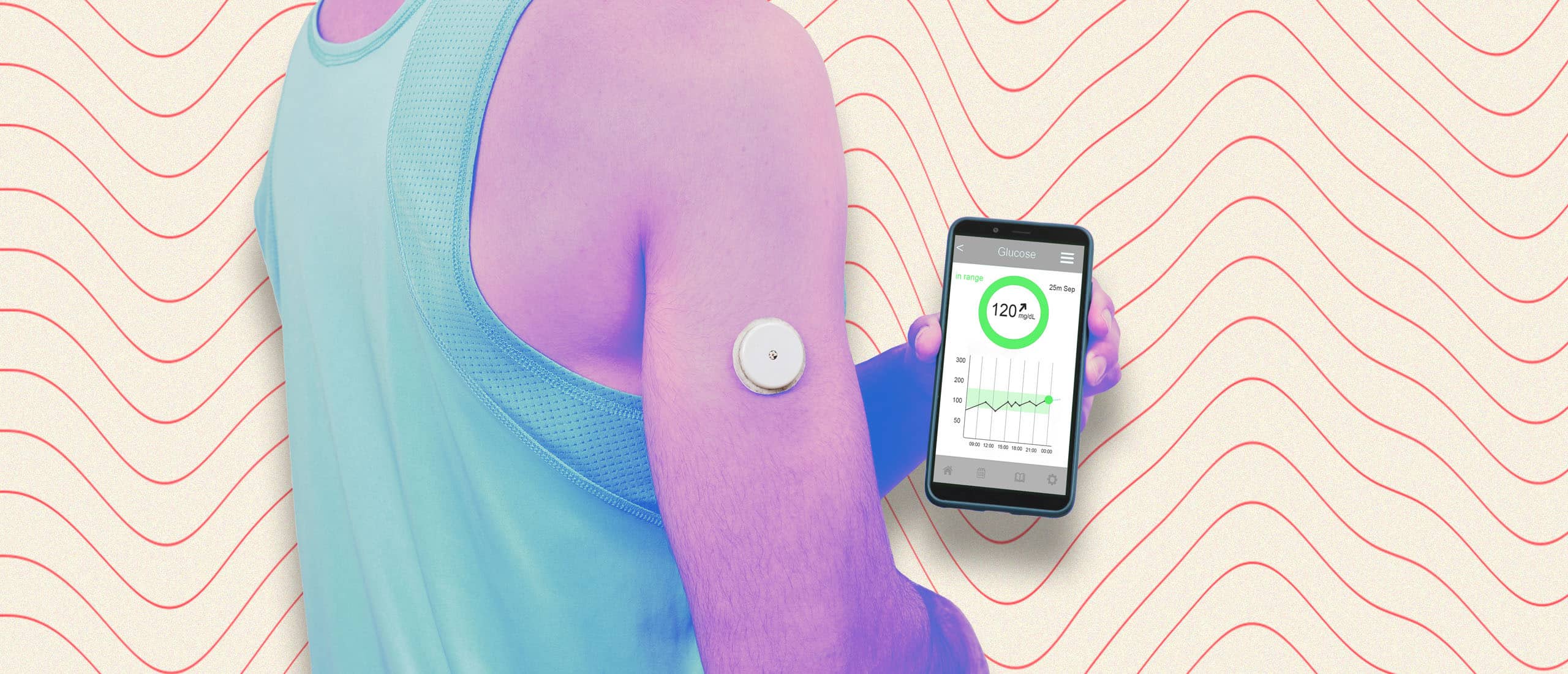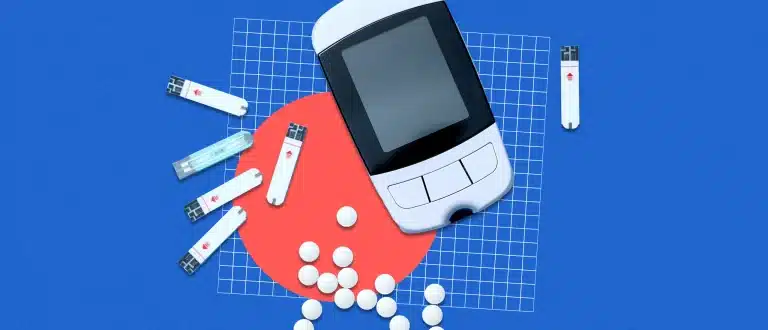Why Wearing a CGM Could Help You Live Longer, According to Longevity Experts
Americans run on high blood sugar. The CDC estimates nearly 100 million American adults are living with prediabetes (and about 80 percent don’t even know it), while tens of millions more are type 2 diabetic.
There are a number of realistic steps you can take to prevent or delay type 2 diabetes, according to the National Institutes of Health: Maintain a healthy weight, move more, and eat healthy most of the time. Taking the drug metformin to manage blood sugar is another solid option. But if you want to squash your risk, and fast, the most direct bet is one many diabetics are already using—continuous glucose monitors, or CGMs.
A continuous glucose monitor is one of the best ways to learn exactly how your blood sugar responds to different foods. After using one you’ll quickly learn the obvious foods (hello, Big Gulp) and not-so-obvious ones (pulled pork?) that spike your blood sugar.
Some critics argue that if you’re healthy, using a CGM is overkill. But longevity experts like physician Peter Attia, M.D., and researcher David Sinclair, Ph.D. are bullish on them.
First, What is a CGM?
A continuous glucose monitor is a wearable device that measures blood glucose levels in real time. Originally designed for people who have diabetes, CGMs provide a reflection of your current glycemic state—or your current blood glucose levels. CGMs can be used to track your glycemic response—or the effect that a meal, snack, or drink has on blood sugar levels—throughout the day.
Blood glucose variability (high highs and low lows) can predispose you to diabetes (1). A CGM won’t change your blood sugar response, but it does give you information about how your body responds to the foods you eat so you can make changes to flatten the curve and lower the average.
What Causes Blood Glucose Spikes?
Carbs are hands down the biggest culprits of blood glucose spikes. Typically the more sugar- or carb-heavy a food is, the more drastic the spike.
If you’re wondering why you need a CGM if you know a donut is going to spike your blood sugar anyways, glad you asked. While some foods like candy and soda are basically guaranteed to catapult blood sugar levels, your glycemic response is highly individualized and influenced by your gut microbiome (2). Meaning, while rice might send your neighbor’s blood glucose through the roof, it might do nothing to yours.
Your glycemic response to any food can also change depending on when you eat it and what other foods it’s paired with; your exercise routine, sleep quality, and stress levels (3, 4, 5, 6, 7).
The Link Between Blood Glucose and Longevity
When blood glucose runs high, insulin steps in to shuttle glucose from your blood into your cells where it can be used for energy. If your glycemic response is dysregulated, however, your body slowly becomes resistant to the effects of insulin and needs more of it to keep your blood sugar even—aka insulin resistance.
Insulin resistance is linked to three out of four of what Attia has coined the “four horsemen” of chronic disease—cancer, diabetes, and heart disease—the diseases most likely to shorten your lifespan. “When insulin resistance begins to develop, the train is already well down the track towards type 2 diabetes, which brings a multitude of unpleasant consequences,” Attia wrote in Outlive. “Insulin is also a potent growth-signaling hormone that helps foster both atherosclerosis and cancer.”
Plus, excessive amounts of sugar can increase cellular aging. In other words, too much sugar may reduce your healthspan and lifespan (8). According to Sinclair, it all comes back to Adenosine 5’ monophosphate-activated protein kinase (AMPK), an enzyme known as the body’s master regulator of energy metabolism. AMPK is linked to blood sugar. When cells are starved of glucose, like when fasting, AMPK is activated.
“One of the main things that [AMPK] does is it makes more mitochondria. We lose mitochondria as we get older,” Sinclair says. Poor mitochondrial function is linked to heart disease (9), dementia (10), type 2 diabetes (11), metabolic syndrome (12), and insulin resistance (13). “Mitochondria are important for metabolizing what we eat and making chemical energy,” Sinclair says. “That’s why when you activate AMPK you’ll have more energy, and feel better.”
Why Healthy Adults Should Wear a CGM, According to Longevity Experts
“I think nearly every adult could benefit from [wearing a CGM], at least for a few weeks,” Attia writes in Outlive.
Why? “Knowing your blood sugar levels is one of the most important components of creating optimal health,” functional medicine doctor Mark Hyman. M.D. told Levels. Since your glycemic response is individualized, using a CGM is the difference between guessing what spikes your blood glucose, or knowing for sure.
When Sinclair first started using a CGM, he quickly learned that rice spiked his glucose through the roof. Potatoes, on the other hand, weren’t so bad. Cell biologist Rhonda Patrick, Ph.D. uses a CGM to monitor her ratio of sugar to fiber. “One of the things that’s really consistent with lowering the [post-meal] glucose response is more fiber,” she told Lewis Howes on The School of Greatness podcast. Because your body can’t break down and absorb fiber, it doesn’t spike your blood sugar levels and keeps them in check.
Saying continuous glucose monitors are only for diabetics is like saying bathroom scales are only for the obese #wellness
— David Sinclair (@davidasinclair) July 14, 2021
You likely won’t need to wear one long to see the benefit. “Typically, my healthy patients need to use a CGM only for a month or two before they begin to understand what foods are spiking their glucose (and insulin) and how to adjust their eating pattern to obtain a more stable glucose curve. Once they have this knowledge, many of them no longer need CGM,” Attia writes in Outlive.
To critics who speculate if CGMs are just another addition to toxic optimization’s ever-growing list, Attia begs to differ. “It seems quite clear that we want to lower average blood glucose and reduce the amount of variability from day to day and hour to hour. CGM is a tool that can help us achieve that. We use it in healthy people in order to help them stay healthy. That shouldn’t be controversial,” he says.
How Longevity Experts Use CGMs
Want to dial in your glucose response? Longevity experts have advice. Here are a few tips that helped them flatten the curve pronto.
Eat less sugar
A CGM can help you dial in which foods spike your blood glucose and which keep it humming along at a steady pace. But learning from others’ mistakes can help speed up the process. To state the obvious, you’re going to want to eat less sugar.
In an episode of Lifespan, Sinclair suggests eating less sugar, less often to minimize glucose spikes. He usually avoids sugar, leaning on sugar-free alternatives to add sweetness to his food. Patrick agrees. “In my opinion, the best thing you can do is cut [refined sugar] out,” she told The Tim Ferris Show. “You’ll be so much healthier by just cutting out this one thing.”
Balance carbs with protein, fat, and fiber
When Sinclair does eat dessert, he expertly eats it after a balanced meal to reduce glucose spikes. If your dessert is packed with carbs and sugars (what good dessert isn’t?) one study found that eating it after veggies and protein significantly reduces post-meal glucose and insulin levels (14).
If worrying about the order you eat feels like overkill, focus on eating snacks and meals that have a balance of macronutrients—carbs with protein, fat, and/or fiber (15). “This means having your rice with chicken and broccoli, adding avocado and an egg to your toast, or eating a banana with a tablespoon of nut butter,” registered dietitian Anna Brown, M.S., R.D. previously told The Edge.
Eat less often
At a high level, glucose shuts off AMPK—the helpful enzyme that protects your energy and boosts mitochondria production. To avoid this unfavorable shift, Sinclair recommends eating less often to keep your blood sugar levels balanced. “If you’re eating three meals a day plus snacks, your glucose will spike, and your defenses against aging are going to be working at a minimum,” he explains.
Eating less often can help streamline glucose levels, and thus, mobilize AMPK. “It’s not just about the period of eating, it’s the period of not eating that’s so important to boost the body’s defenses against aging to maximize longevity,” Sinclair adds. Plus, it doesn’t hurt that most longevity experts agree intermittent fasting (so long as you get enough protein) can help boost your lifespan, too.















